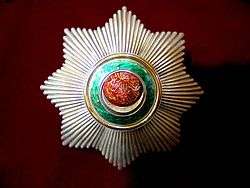Order of Osmanieh
The Order of Osmanieh or Order of Osmaniye (Turkish: Osmanlı Devlet Nişanı) was a civil and military decoration of the Ottoman Empire.
| Order of Osmanieh | |
|---|---|
 Third Class Order of Osmanieh | |
| Awarded by Ottoman Sultan | |
| Country | Ottoman Empire |
| Type | Order |
| Eligibility | Civilians and military |
| Awarded for | Outstanding services to the state |
| Status | No longer awarded |
| Clasps | Swords for World War I |
| Statistics | |
| Established | January 1862 |
| Precedence | |
| Next (higher) | Order of Glory (until 1862) Order of Distinction (after 1862) |
Ribbon bar of the medal | |
History
The order was created in January 1862 by Sultan Abdülaziz.[1] With the obsolescence of the Nişan-i Iftikhar, this became the second highest order in the Empire, ranking below the Nişan-i Imtiyaz. It was awarded by the Sultan to Ottoman civil servants and military leaders for outstanding services to the state. Generally, it could not be awarded to women, but exceptions appear to have been made at the Sultan's discretion. The order was originally established in three classes. In 1867 the order was expanded to four classes, plus an augmented first class set with brilliants or diamonds (This does not include the awards with sabers, which were not separate classes, but did constitute separate awards). The order was restricted (for Turkish recipients) to 50 members of the first class, 200 members of the second class, 1000 of the third class, and 2000 of the fourth class. Originally, one could not receive the first class of this order without having first been decorated with the First Class of the Order of the Medjidie, but during the 33-year reign of Abdulhamid II, most of these restrictions were ignored and the first class of both orders were awarded liberally. A fifth class was added in 1893.[1]
From 1915 until the end of the First World War, all classes could be awarded with sabers when awarded for achievements in military operations.[1]

Description
The badge of the order is a seven pointed star in dark green enamel, with three short silver rays between each point of the star. The center medallion is in gold, with a red enameled field surrounded by a green enameled band. In the red central portion is a raised gold crescent, and a calligraphic inscription reading "Relying on the Assistance of Almighty God, Abdulaziz Khan, Sovereign of the Ottoman Empire". The reverse center medallion is silver, bearing a trophy of arms and the year AH. 699, the year of the creation of the Ottoman Empire. The badge is suspended by a gold crescent and star, facing upwards.[2] The star of the order bears the same obverse center medallion superimposed on a silver seven pointed star of faceted rays. A star of the first class typically measures about 100 mm, while that of the second class measures about 90 mm across, with the Ottoman mint mark on the reverse.[3]
References
- "Turkish Order of the Osmanieh, 4th Class". www.awm.gov.au.
- "Order of Osmanieh, 1st class. Badge and sash. Possibly belonged to Edward VII". Royal Collection Trust. Inventory no. 441052.
- "Order of Osmanieh Grand Officer 2nd class neck badge and breast star". Archived from the original on 2013-02-09. Retrieved 2013-07-26.